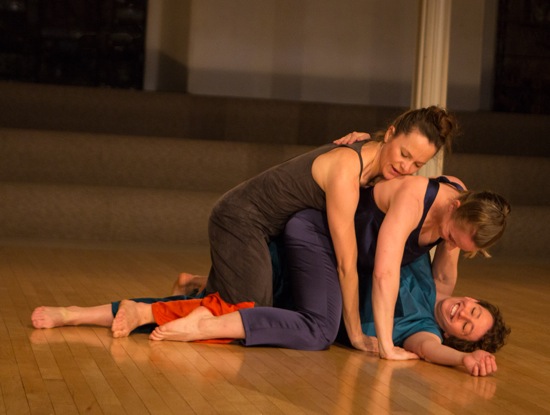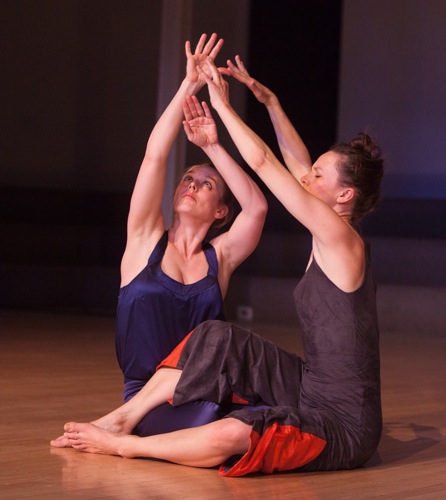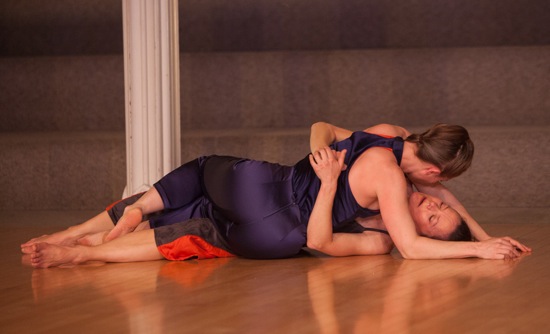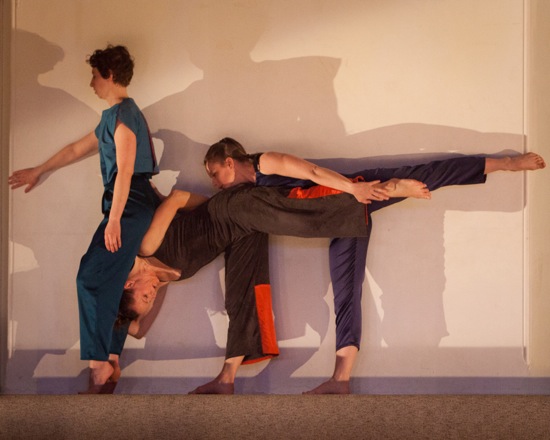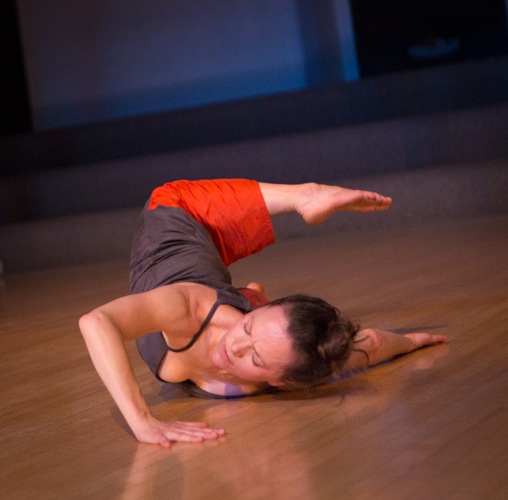[Katie Workum’s Black Lakes at St. Mark’s Church, April 9 through 11]
I didn’t read the note that Katie Workum added to the program for her Black Lakes. This was not because I heeded her spoiler alert, which warned spectators who liked to approach a work with fresh eyes not to read further. I didn’t see even see the alert. I came to the Danspace Project presentation in St. Mark’s church tired, so how fresh were my eyes? But something interesting happened. Workum walked into the space, her eyes closed, and stood right in front of me, close to the center of the big half circle of chairs. And she breathed so deeply and stood so still that I wondered if I was going to fall asleep. Instead, breathing with her, I woke up.
Even without the information that Workum, Weena Pauly, and Eleanor Smith were improvising in accord with certain guidelines and timings (I had—to be completely truthful—inferred it from the press release), I think I would have guessed that. Experienced improvisers pay the kind of attention to one another that few dancers performing someone else’s choreography do. They’re as alert as animals to everything they see and hear. And, in the case of these three, what they sense through their skins. Although presenting an improvisation as a product that changes from performance to performance, rather than choreographing every minute of a dance, is a new development for Workum, she, Pauly, and Smith have been improvising together daily for years, their sessions informed by the practice known as Authentic Movement, in which some are dancing with their eyes closed, while others are witnesses.
The women’s occasional misadventures also reveal that they are improvising—misadventures that in this low-key, sensitive work can be as kinesthetically stimulating as a virtuoso act. Workum, running backward with her eyes closed, trips over Pauly and Smith, who are close together on the floor. I feel the jolt. Sometimes they will collaborate on a complicated maneuver that ends in a tumble; you can see it coming and feel “watch out!” forming in your throat. When Pauly gets between the other two—all their eyes are open at this point—an amicable scuffle morphs into a stroll by the three of them pressed together spoon-fashion. This is so hard to do well, yet so playground-silly that we laugh. . . .or did their laughter trigger ours?
These women, whether working with their eyes closed or open, are wise to one another’s bodies, their weight, height, preferred timings, habitual responses. That makes them reckless—at least, within limits. Pauly catches Workum’s neck in the crook of her elbow and maneuvers her to the floor. Then, after watching her colleague roll around, dives on top of her (“Oof!”). Workum gets hold of Smith and drags her around the space; sometimes Smith is on her knees, sometimes she’s sitting.
None of this seems cruel, and many of the tangles and supports are beautiful as well as unusual—fluidly arrived at, seriously performed, and then organically disarranged. The three are often tender with one another. At one point, Smith and Pauly keep their heads pressed together, even while they turn. Workum places Pauly’s hand against her face and nuzzles it the way a cat wanting to be petted might.
The overall rhythm of Black Lakes is one of people watching, sensing how to join or provide help, then acting on a decision. One person’s innovation can suck a second person in, while a third one finds a way to turn the ongoing movements in a new direction. A staggering gallop in a circle may entice others to join. Or not. There are also chances to go it alone. Smith, on her belly, approaches one of the church’s pillars, slides her chest up it a foot or so, and lies there for a while, resting in a position I can’t imagine as comfortable.
There’s a certain elegance to Black Lakes along with its earthiness, sensuousness and adventurousness. That’s true of the ambience too. James Lo’s sound design starts so quietly and so sparsely that you’re not sure that the barely discernible noise you hear and the click that shuts it off isn’t a radiator. Pretty soon, the music quietly envelops you (speakers are placed both behind and in front of the performing area). And it does get louder, but it also disappears entirely, or starts up a soft tinkling, a bit like that of bamboo wood chimes. Carrie Wood’s lighting is also subtle, although it can fade to a bluish cast or warm up or become startlingly bright for a while. Mindy Nelson has dressed the dancers outfits that have a casual cut, but are made of dark fabrics that shine and may incorporate patches of brighter color.
At the first of the three performances, I noticed something that may have been a fortuitous accident, although it could have been Wood’s doing. As the women found new ways to move alone and together, with eyes open or closed, one of the church’s stained glass windows began to glow slightly—perhaps from an outside light. Embedded in it is the image of Peter Stuyvesant, whose grave is on the premises. From across the space of the church and across five centuries, he gazed at three women keen of mind and freer in their bodies and spirits than anyone he might have known when he was Director-General of the small town the Dutch called New Amsterdam.

